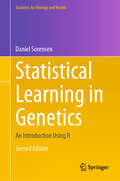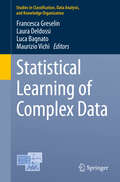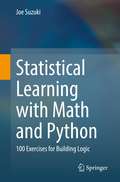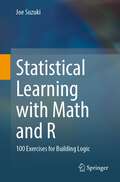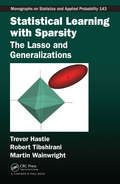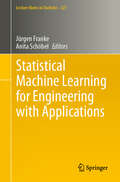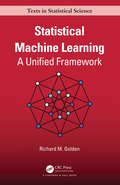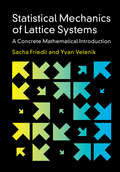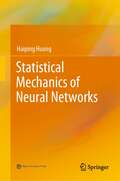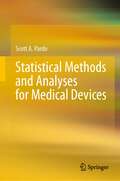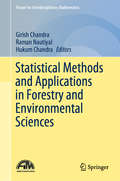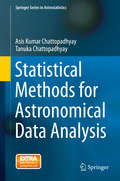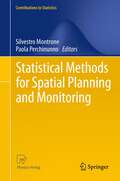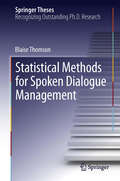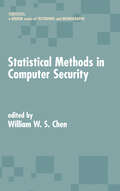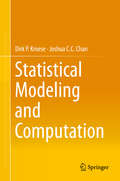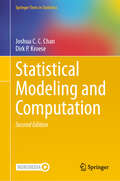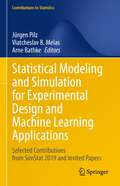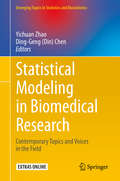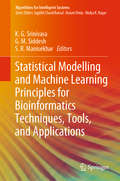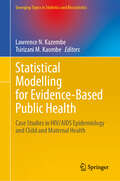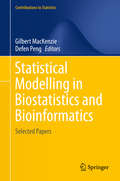- Table View
- List View
Statistical Learning and Data Science
by Fionn Murtagh Mireille Gettler Summa Léon Bottou Bernard Goldfarb Catherine Pardoux Myriam TouatiData analysis is changing fast. Driven by a vast range of application domains and affordable tools, machine learning has become mainstream. Unsupervised data analysis, including cluster analysis, factor analysis, and low dimensionality mapping methods continually being updated, have reached new heights of achievement in the incredibly rich data wor
Statistical Learning in Genetics: An Introduction Using R (Statistics for Biology and Health)
by Daniel SorensenThis book provides an introduction to computer-based methods for the analysis of genomic data. Breakthroughs in molecular and computational biology have contributed to the emergence of vast data sets, where millions of genetic markers for each individual are coupled with medical records, generating an unparalleled resource for linking human genetic variation to human biology and disease. Similar developments have taken place in animal and plant breeding, where genetic marker information is combined with production traits. An important task for the statistical geneticist is to adapt, construct and implement models that can extract information from these large-scale data. An initial step is to understand the methodology that underlies the probability models and to learn the modern computer-intensive methods required for fitting these models. The objective of this book, suitable for readers who wish to develop analytic skills to perform genomic research, is to provide guidance to take this first step. This book is addressed to numerate biologists who may lack the formal mathematical background of the professional statistician. For this reason, considerably more detailed explanations and derivations are offered. Examples are used profusely and a large proportion involves programming with the open-source package R. The code needed to solve the exercises is provided and it can be downloaded, allowing students to experiment by running the programs on their own computer. Part I presents methods of inference and computation that are appropriate for likelihood and Bayesian models. Part II discusses prediction for continuous and binary data using both frequentist and Bayesian approaches. Some of the models used for prediction are also used for gene discovery. The challenge is to find promising genes without incurring a large proportion of false positive results. Therefore, Part II includes a detour on the False Discovery Rate, assuming frequentist and Bayesian perspectives. The last chapter of Part II provides an overview of a selected number of non-parametric methods. Part III consists of exercises and their solutions. This second edition has benefited from many clarifications and extensions of themes discussed in the first edition. Daniel Sorensen holds PhD and DSc degrees from the Univ
Statistical Learning of Complex Data (Studies in Classification, Data Analysis, and Knowledge Organization)
by Maurizio Vichi Francesca Greselin Laura Deldossi Luca BagnatoThis book of peer-reviewed contributions presents the latest findings in classification, statistical learning, data analysis and related areas, including supervised and unsupervised classification, clustering, statistical analysis of mixed-type data, big data analysis, statistical modeling, graphical models and social networks. It covers both methodological aspects as well as applications to a wide range of fields such as economics, architecture, medicine, data management, consumer behavior and the gender gap. In addition, it describes the basic features of the software behind the data analysis results, and provides links to the corresponding codes and data sets where necessary. This book is intended for researchers and practitioners who are interested in the latest developments and applications in the field of data analysis and classification. It gathers selected and peer-reviewed contributions presented at the 11th Scientific Meeting of the Classification and Data Analysis Group of the Italian Statistical Society (CLADAG 2017), held in Milan, Italy, on September 13–15, 2017.
Statistical Learning with Math and Python: 100 Exercises for Building Logic
by Joe SuzukiThe most crucial ability for machine learning and data science is mathematical logic for grasping their essence rather than knowledge and experience. This textbook approaches the essence of machine learning and data science by considering math problems and building Python programs. As the preliminary part, Chapter 1 provides a concise introduction to linear algebra, which will help novices read further to the following main chapters. Those succeeding chapters present essential topics in statistical learning: linear regression, classification, resampling, information criteria, regularization, nonlinear regression, decision trees, support vector machines, and unsupervised learning. Each chapter mathematically formulates and solves machine learning problems and builds the programs. The body of a chapter is accompanied by proofs and programs in an appendix, with exercises at the end of the chapter. Because the book is carefully organized to provide the solutions to the exercises in each chapter, readers can solve the total of 100 exercises by simply following the contents of each chapter. This textbook is suitable for an undergraduate or graduate course consisting of about 12 lectures. Written in an easy-to-follow and self-contained style, this book will also be perfect material for independent learning.
Statistical Learning with Math and R: 100 Exercises for Building Logic
by Joe SuzukiThe most crucial ability for machine learning and data science is mathematical logic for grasping their essence rather than knowledge and experience. This textbook approaches the essence of machine learning and data science by considering math problems and building R programs. As the preliminary part, Chapter 1 provides a concise introduction to linear algebra, which will help novices read further to the following main chapters. Those succeeding chapters present essential topics in statistical learning: linear regression, classification, resampling, information criteria, regularization, nonlinear regression, decision trees, support vector machines, and unsupervised learning. Each chapter mathematically formulates and solves machine learning problems and builds the programs. The body of a chapter is accompanied by proofs and programs in an appendix, with exercises at the end of the chapter. Because the book is carefully organized to provide the solutions to the exercises in each chapter, readers can solve the total of 100 exercises by simply following the contents of each chapter. This textbook is suitable for an undergraduate or graduate course consisting of about 12 lectures. Written in an easy-to-follow and self-contained style, this book will also be perfect material for independent learning.
Statistical Learning with Sparsity: The Lasso and Generalizations (Chapman & Hall/CRC Monographs on Statistics and Applied Probability)
by Trevor Hastie Robert Tibshirani Martin WainwrightDiscover New Methods for Dealing with High-Dimensional DataA sparse statistical model has only a small number of nonzero parameters or weights; therefore, it is much easier to estimate and interpret than a dense model. Statistical Learning with Sparsity: The Lasso and Generalizations presents methods that exploit sparsity to help recover the underl
Statistical Machine Learning for Engineering with Applications (Lecture Notes in Statistics #227)
by Anita Schöbel Jürgen FrankeThis book offers a leisurely introduction to the concepts and methods of machine learning. Readers will learn about classification trees, Bayesian learning, neural networks and deep learning, the design of experiments, and related methods. For ease of reading, technical details are avoided as far as possible, and there is a particular emphasis on applicability, interpretation, reliability and limitations of the data-analytic methods in practice. To cover the common availability and types of data in engineering, training sets consisting of independent as well as time series data are considered. To cope with the scarceness of data in industrial problems, augmentation of training sets by additional artificial data, generated from physical models, as well as the combination of machine learning and expert knowledge of engineers are discussed. The methodological exposition is accompanied by several detailed case studies based on industrial projects covering a broad range of engineering applications from vehicle manufacturing, process engineering and design of materials to optimization of production processes based on image analysis. The focus is on fundamental ideas, applicability and the pitfalls of machine learning in industry and science, where data are often scarce. Requiring only very basic background in statistics, the book is ideal for self-study or short courses for engineering and science students.
Statistical Machine Learning: A Unified Framework (Chapman & Hall/CRC Texts in Statistical Science)
by Richard GoldenThe recent rapid growth in the variety and complexity of new machine learning architectures requires the development of improved methods for designing, analyzing, evaluating, and communicating machine learning technologies. Statistical Machine Learning: A Unified Framework provides students, engineers, and scientists with tools from mathematical statistics and nonlinear optimization theory to become experts in the field of machine learning. In particular, the material in this text directly supports the mathematical analysis and design of old, new, and not-yet-invented nonlinear high-dimensional machine learning algorithms. Features: Unified empirical risk minimization framework supports rigorous mathematical analyses of widely used supervised, unsupervised, and reinforcement machine learning algorithms Matrix calculus methods for supporting machine learning analysis and design applications Explicit conditions for ensuring convergence of adaptive, batch, minibatch, MCEM, and MCMC learning algorithms that minimize both unimodal and multimodal objective functions Explicit conditions for characterizing asymptotic properties of M-estimators and model selection criteria such as AIC and BIC in the presence of possible model misspecification This advanced text is suitable for graduate students or highly motivated undergraduate students in statistics, computer science, electrical engineering, and applied mathematics. The text is self-contained and only assumes knowledge of lower-division linear algebra and upper-division probability theory. Students, professional engineers, and multidisciplinary scientists possessing these minimal prerequisites will find this text challenging yet accessible. About the Author: Richard M. Golden (Ph.D., M.S.E.E., B.S.E.E.) is Professor of Cognitive Science and Participating Faculty Member in Electrical Engineering at the University of Texas at Dallas. Dr. Golden has published articles and given talks at scientific conferences on a wide range of topics in the fields of both statistics and machine learning over the past three decades. His long-term research interests include identifying conditions for the convergence of deterministic and stochastic machine learning algorithms and investigating estimation and inference in the presence of possibly misspecified probability models.
Statistical Machine Translation
by Philipp KoehnThe filed of machine translation has recently been energized by the emergence of statistical techniques, which have brought the dream of automatic language translation closer to reality. This class-tested textbook, authored by an active researcher in the field, provides a gentle and accessible introduction to the latest methods and enables the reader to build machine translation systems for any language pair.
Statistical Mechanics of Lattice Systems: A Concrete Mathematical Introduction
by Sacha Friedli Yvan VelenikThis motivating textbook gives a friendly, rigorous introduction to fundamental concepts in equilibrium statistical mechanics, covering a selection of specific models, including the Curie–Weiss and Ising models, the Gaussian free field, O(n) models, and models with Kać interactions. Using classical concepts such as Gibbs measures, pressure, free energy, and entropy, the book exposes the main features of the classical description of large systems in equilibrium, in particular the central problem of phase transitions. It treats such important topics as the Peierls argument, the Dobrushin uniqueness, Mermin–Wagner and Lee–Yang theorems, and develops from scratch such workhorses as correlation inequalities, the cluster expansion, Pirogov–Sinai Theory, and reflection positivity. Written as a self-contained course for advanced undergraduate or beginning graduate students, the detailed explanations, large collection of exercises (with solutions), and appendix of mathematical results and concepts also make it a handy reference for researchers in related areas. Builds a narrative around the driving concepts, focusing on specific examples and models. Self-contained and accessible. Features numerous exercises and solutions, as well as a comprehensive appendix.
Statistical Mechanics of Neural Networks
by Haiping HuangThis book highlights a comprehensive introduction to the fundamental statistical mechanics underneath the inner workings of neural networks. The book discusses in details important concepts and techniques including the cavity method, the mean-field theory, replica techniques, the Nishimori condition, variational methods, the dynamical mean-field theory, unsupervised learning, associative memory models, perceptron models, the chaos theory of recurrent neural networks, and eigen-spectrums of neural networks, walking new learners through the theories and must-have skillsets to understand and use neural networks. The book focuses on quantitative frameworks of neural network models where the underlying mechanisms can be precisely isolated by physics of mathematical beauty and theoretical predictions. It is a good reference for students, researchers, and practitioners in the area of neural networks.
Statistical Methods and Analyses for Medical Devices
by Scott A. PardoThis book provides a reference for people working in the design, development, and manufacturing of medical devices. While there are no statistical methods specifically intended for medical devices, there are methods that are commonly applied to various problems in the design, manufacturing, and quality control of medical devices. The aim of this book is not to turn everyone working in the medical device industries into mathematical statisticians; rather, the goal is to provide some help in thinking statistically, and knowing where to go to answer some fundamental questions, such as justifying a method used to qualify/validate equipment, or what information is necessary to support the choice of sample sizes.While, there are no statistical methods specifically designed for analysis of medical device data, there are some methods that seem to appear regularly in relation to medical devices. For example, the assessment of receiver operating characteristic curves is fundamental to development of diagnostic tests, and accelerated life testing is often critical for assessing the shelf life of medical device products. Another example is sensitivity/specificity computations are necessary for in-vitro diagnostics, and Taguchi methods can be very useful for designing devices. Even notions of equivalence and noninferiority have different interpretations in the medical device field compared to pharmacokinetics. It contains topics such as dynamic modeling, machine learning methods, equivalence testing, and experimental design, for example.This book is for those with no statistical experience, as well as those with statistical knowledgeable—with the hope to provide some insight into what methods are likely to help provide rationale for choices relating to data gathering and analysis activities for medical devices.
Statistical Methods and Applications in Forestry and Environmental Sciences (Forum for Interdisciplinary Mathematics)
by Girish Chandra Raman Nautiyal Hukum ChandraThis book presents recent developments in statistical methodologies with particular relevance to applications in forestry and environmental sciences. It discusses important methodologies like ranked set sampling, adaptive cluster sampling, small area estimation, calibration approach-based estimators, design of experiments, multivariate techniques, Internet of Things, and ridge regression methods. It also covers the history of the implementation of statistical techniques in Indian forestry and the National Forest Inventory of India.The book is a valuable resource for applied statisticians, students, researchers, and practitioners in the forestry and environment sector. It includes real-world examples and case studies to help readers apply the techniques discussed. It also motivates academicians and researchers to use new technologies in the areas of forestry and environmental sciences with the help of software like R, MATLAB, Statistica, and Mathematica.
Statistical Methods for Astronomical Data Analysis
by Asis Kumar Chattopadhyay Tanuka ChattopadhyayThis book introduces "Astrostatistics" as a subject in its own right with rewarding examples, including work by the authors with galaxy and Gamma Ray Burst data to engage the reader. This includes a comprehensive blending of Astrophysics and Statistics. The first chapter's coverage of preliminary concepts and terminologies for astronomical phenomenon will appeal to both Statistics and Astrophysics readers as helpful context. Statistics concepts covered in the book provide a methodological framework. A unique feature is the inclusion of different possible sources of astronomical data, as well as software packages for converting the raw data into appropriate forms for data analysis. Readers can then use the appropriate statistical packages for their particular data analysis needs. The ideas of statistical inference discussed in the book help readers determine how to apply statistical tests. The authors cover different applications of statistical techniques already developed or specifically introduced for astronomical problems, including regression techniques, along with their usefulness for data set problems related to size and dimension. Analysis of missing data is an important part of the book because of its significance for work with astronomical data. Both existing and new techniques related to dimension reduction and clustering are illustrated through examples. There is detailed coverage of applications useful for classification, discrimination, data mining and time series analysis. Later chapters explain simulation techniques useful for the development of physical models where it is difficult or impossible to collect data. Finally, coverage of the many R programs for techniques discussed makes this book a fantastic practical reference. Readers may apply what they learn directly to their data sets in addition to the data sets included by the authors.
Statistical Methods for Recommender Systems
by Deepak K. Agarwal Bee-Chung ChenDesigning algorithms to recommend items such as news articles and movies to users is a challenging task in numerous web applications. The crux of the problem is to rank items based on users' responses to different items to optimize for multiple objectives. Major technical challenges are high dimensional prediction with sparse data and constructing high dimensional sequential designs to collect data for user modeling and system design. This comprehensive treatment of the statistical issues that arise in recommender systems includes detailed, in-depth discussions of current state-of-the-art methods such as adaptive sequential designs (multi-armed bandit methods), bilinear random-effects models (matrix factorization) and scalable model fitting using modern computing paradigms like MapReduce. The authors draw upon their vast experience working with such large-scale systems at Yahoo! and LinkedIn, and bridge the gap between theory and practice by illustrating complex concepts with examples from applications they are directly involved with.
Statistical Methods for Spatial Planning and Monitoring
by Silvestro Montrone Paola PerchinunnoThe book aims to investigate methods and techniques for spatial statistical analysis suitable to model spatial information in support of decision systems. Over the last few years there has been a considerable interest in these tools and in the role they can play in spatial planning and environmental modelling. One of the earliest and most famous definition of spatial planning was "a geographical expression to the economic, social, cultural and ecological policies of society": borrowing from this point of view, this text shows how an interdisciplinary approach is an effective way to an harmonious integration of national policies with regional and local analysis. A wide range of spatial models and techniques is, also, covered: spatial data mining, point processes analysis, nearest neighbor statistics and cluster detection, Fuzzy Regression model and local indicators of spatial association; all of these tools provide the policy-maker with a valuable support to policy development.
Statistical Methods for Spoken Dialogue Management
by Blaise ThomsonSpeech is the most natural mode of communication and yet attempts to build systems which support robust habitable conversations between a human and a machine have so far had only limited success. A key reason is that current systems treat speech input as equivalent to a keyboard or mouse, and behaviour is controlled by predefined scripts that try to anticipate what the user will say and act accordingly. But speech recognisers make many errors and humans are not predictable; the result is systems which are difficult to design and fragile in use. Statistical methods for spoken dialogue management takes a radically different view. It treats dialogue as the problem of inferring a user's intentions based on what is said. The dialogue is modelled as a probabilistic network and the input speech acts are observations that provide evidence for performing Bayesian inference. The result is a system which is much more robust to speech recognition errors and for which a dialogue strategy can be learned automatically using reinforcement learning. The thesis describes both the architecture, the algorithms needed for fast real-time inference over very large networks, model parameter estimation and policy optimisation. This ground-breaking work will be of interest both to practitioners in spoken dialogue systems and to cognitive scientists interested in models of human behaviour.
Statistical Methods in Computer Security (Statistics: A Series of Textbooks and Monographs)
by William W. S. ChenStatistical Methods in Computer Security summarizes discussions held at the recent Joint Statistical Meeting to provide a clear layout of current applications in the field. This blue-ribbon reference discusses the most influential advancements in computer security policy, firewalls, and security issues related to passwords. It addresses crime and m
Statistical Modeling and Computation
by Dirk P. Kroese Joshua C.C. ChanThis textbook on statistical modeling and statistical inference will assist advanced undergraduate and graduate students. Statistical Modeling and Computation provides a unique introduction to modern Statistics from both classical and Bayesian perspectives. It also offers an integrated treatment of Mathematical Statistics and modern statistical computation, emphasizing statistical modeling, computational techniques, and applications. Each of the three parts will cover topics essential to university courses. Part I covers the fundamentals of probability theory. In Part II, the authors introduce a wide variety of classical models that include, among others, linear regression and ANOVA models. In Part III, the authors address the statistical analysis and computation of various advanced models, such as generalized linear, state-space and Gaussian models. Particular attention is paid to fast Monte Carlo techniques for Bayesian inference on these models. Throughout the book the authors include a large number of illustrative examples and solved problems. The book also features a section with solutions, an appendix that serves as a MATLAB primer, and a mathematical supplement.
Statistical Modeling and Computation (Springer Texts in Statistics)
by Dirk P. Kroese Joshua C. ChanThis book, Statistical Modeling and Computation, provides a unique introduction to modern statistics from both classical and Bayesian perspectives. It also offers an integrated treatment of mathematical statistics and modern statistical computation, emphasizing statistical modeling, computational techniques, and applications. The 2nd edition changes the programming language used in the text from MATLAB to Julia. For all examples with computing components, the authors provide data sets and their own Julia codes. The new edition features numerous full color graphics to illustrate the concepts discussed in the text, and adds three entirely new chapters on a variety of popular topics, including: Regularization and the Lasso regression Bayesian shrinkage methods Nonparametric statistical tests Splines and the Gaussian process regression Joshua C. C. Chan is Professor of Economics, and holds the endowed Olson Chair at Purdue University. He is an elected fellow at the International Association for Applied Econometrics and served as Chair for the Economics, Finance and Business Section of the International Society for Bayesian Analysis from 2020-2022. His research focuses on building new high-dimensional time-series models and developing efficient estimation methods for these models. He has published over 50 papers in peer-reviewed journals, including some top-field journals such as Journal of Econometrics, Journal of the American Statistical Association and Journal of Business and Economic Statistics. Dirk Kroese is Professor of Mathematics and Statistics at the University of Queensland. He is known for his significant contributions to the fields of applied probability, mathematical statistics, machine learning, and Monte Carlo methods. He has published over 140 articles and 7 books. He is a pioneer of the well-known Cross-Entropy (CE) method, which is being used around the world to help solve difficult estimation and optimization problems in science, engineering, and finance. In addition to his scholarly contributions, Dirk Kroese is recognized for his role as an educator and mentor, having supervised and inspired numerous students and researchers.
Statistical Modeling and Simulation for Experimental Design and Machine Learning Applications: Selected Contributions from SimStat 2019 and Invited Papers (Contributions to Statistics)
by Jürgen Pilz Viatcheslav B. Melas Arne BathkeThis volume presents a selection of articles on statistical modeling and simulation, with a focus on different aspects of statistical estimation and testing problems, the design of experiments, reliability and queueing theory, inventory analysis, and the interplay between statistical inference, machine learning methods and related applications. The refereed contributions originate from the 10th International Workshop on Simulation and Statistics, SimStat 2019, which was held in Salzburg, Austria, September 2–6, 2019, and were either presented at the conference or developed afterwards, relating closely to the topics of the workshop. The book is intended for statisticians and Ph.D. students who seek current developments and applications in the field.
Statistical Modeling in Biomedical Research: Contemporary Topics and Voices in the Field (Emerging Topics in Statistics and Biostatistics)
by Ding-Geng Din Chen Yichuan ZhaoThis edited collection discusses the emerging topics in statistical modeling for biomedical research. Leading experts in the frontiers of biostatistics and biomedical research discuss the statistical procedures, useful methods, and their novel applications in biostatistics research. Interdisciplinary in scope, the volume as a whole reflects the latest advances in statistical modeling in biomedical research, identifies impactful new directions, and seeks to drive the field forward. It also fosters the interaction of scholars in the arena, offering great opportunities to stimulate further collaborations. This book will appeal to industry data scientists and statisticians, researchers, and graduate students in biostatistics and biomedical science. It covers topics in:Next generation sequence data analysisDeep learning, precision medicine, and their applicationsLarge scale data analysis and its applicationsBiomedical research and modelingSurvival analysis with complex data structure and its applications.
Statistical Modelling and Machine Learning Principles for Bioinformatics Techniques, Tools, and Applications (Algorithms for Intelligent Systems)
by K. G. Srinivasa G. M. Siddesh S. R. ManisekharThis book discusses topics related to bioinformatics, statistics, and machine learning, presenting the latest research in various areas of bioinformatics. It also highlights the role of computing and machine learning in knowledge extraction from biological data, and how this knowledge can be applied in fields such as drug design, health supplements, gene therapy, proteomics and agriculture.
Statistical Modelling for Evidence-Based Public Health: Case Studies in HIV/AIDS Epidemiology and Child and Maternal Health (Emerging Topics in Statistics and Biostatistics)
by Lawrence N. Kazembe Tsirizani M. KaombeThis book presents a selection of statistical techniques and methods applied to analyze data arising from HIV/AIDS epidemiology, as well as child and maternal health. Evidence-based decision-making in public health interventions requires appropriate techniques applied to solve relevant statistical and epidemiological questions, which would, in turn, bring out relevant outputs for action. The different chapters assembled in this book, address various methodological challenges when analyzing HIV/AIDS, child and maternal health data. These include data issues for handling correlated outcomes and repeated measurements generated through longitudinal or follow-up processes, spatial-temporal correlation, measurement error, missingness, co-morbidity, survival analysis, detection of outlying health outcomes, and joint occurrences of outcomes. Essential approaches that enhance statistical science, are presented, when dealing with variable and model selection. Each chapter motivates the problem, provides details of the relevant bio-statistical methods used to tackle the problem, applies the methods to the data, and offers some epidemiological or public health recommendations. Readers can replicate the methods to their data, and R command codes are supplied at the end of each chapter.
Statistical Modelling in Biostatistics and Bioinformatics
by Gilbert Mackenzie Defen PengThis book presents selected papers on statistical model development related mainly to the fields of Biostatistics and Bioinformatics. The coverage of the material falls squarely into the following categories: (a) Survival analysis and multivariate survival analysis, (b) Time series and longitudinal data analysis, (c) Statistical model development and (d) Applied statistical modelling. Innovations in statistical modelling are presented throughout each of the four areas, with some intriguing new ideas on hierarchical generalized non-linear models and on frailty models with structural dispersion, just to mention two examples. The contributors include distinguished international statisticians such as Philip Hougaard, John Hinde, Il Do Ha, Roger Payne and Alessandra Durio, among others, as well as promising newcomers. Some of the contributions have come from researchers working in the BIO-SI research programme on Biostatistics and Bioinformatics, centred on the Universities of Limerick and Galway in Ireland and funded by the Science Foundation Ireland under its Mathematics Initiative.

